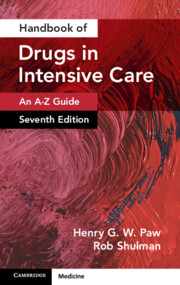Book contents
- Handbook of Drugs in Intensive Care
- Handbook of Drugs in Intensive Care
- Copyright page
- Dedication
- Contents
- Introduction
- How to Use This Book
- Common Abbreviations
- Acknowledgements
- Drugs: An A–Z Guide
- Chapter A
- Chapter B
- Chapter C
- Chapter D
- Chapter E
- Chapter F
- Chapter G
- Chapter H
- Chapter I
- Chapter K
- Chapter L
- Chapter M
- Chapter N
- Chapter O
- Chapter P
- Chapter Q
- Chapter R
- Chapter S
- Chapter T
- Chapter V
- Chapter Z
- Short Notes
- Appendices
- Drug Index
Chapter I
from Drugs: An A–Z Guide
- Handbook of Drugs in Intensive Care
- Handbook of Drugs in Intensive Care
- Copyright page
- Dedication
- Contents
- Introduction
- How to Use This Book
- Common Abbreviations
- Acknowledgements
- Drugs: An A–Z Guide
- Chapter A
- Chapter B
- Chapter C
- Chapter D
- Chapter E
- Chapter F
- Chapter G
- Chapter H
- Chapter I
- Chapter K
- Chapter L
- Chapter M
- Chapter N
- Chapter O
- Chapter P
- Chapter Q
- Chapter R
- Chapter S
- Chapter T
- Chapter V
- Chapter Z
- Short Notes
- Appendices
- Drug Index
Summary
Human normal immunoglobulin is prepared by cold alcohol fractionation of pooled plasma from over 1,000 donations. Individual donor units of plasma are screened for hepatitis B surface antigen (HBsAg) and for the presence of antibodies to human immunodeficiency virus type 1 (HIV-1), HIV-2 or hepatitis C virus (HCV), which, combined with careful donor selection, minimizes the risk of viral transmission. In addition, the testing for HBsAg, HIV-1, HIV-2 and HCV antibodies is repeated on the plasma pools.
- Type
- Chapter
- Information
- Handbook of Drugs in Intensive CareAn A-Z Guide, pp. 162 - 170Publisher: Cambridge University PressPrint publication year: 2025

